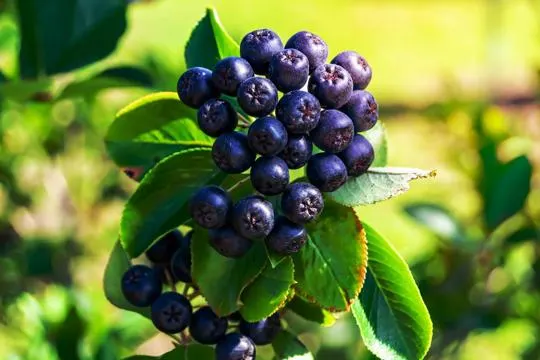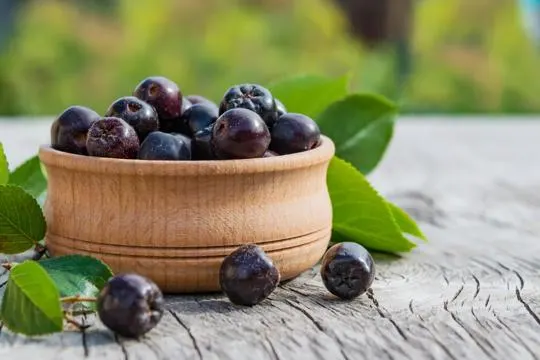Aronia berries and blueberries might look like distant cousins at a family reunion, yet they’re quite distinct. Aronia berries pack a punch with higher antioxidant levels than your everyday blueberries. We stumbled upon this fact while attempting to jazz up a bland smoothie.
Surprise! Aronia turned it from meh to wow. These berries aren’t just health warriors; they carry a unique flavor profile. Blueberries, on the other hand, are the familiar comfort food we all love. They sneak into pancakes and muffins, making weekends feel special.
Aronia and blueberries differ more than we thought.
What are Aronia Berries?

Aronia berries, also known as chokeberries, are dark purple fruits.
They belong to the Rosaceae family and are native to North America.
Recently, they have become popular due to their impressive nutritional profile.
These berries contain high levels of antioxidants, vitamins, and minerals.
Anthocyanins give them their deep color and are believed to be very healthy.
Eating them can help boost your immune system, improve cardiovascular health, and reduce inflammation.
Aronia berries are low in calories but high in fiber.
This makes them great for weight management.
They also contain lots of vitamin C and E which helps with overall well-being.
What makes aronia berries special is their unique flavor.
They have a slight tartness, but also a hint of sweetness.
This makes them good for all kinds of recipes, like smoothies, jams, baked goods, and even savory dishes like salads and marinades.
What are Blueberries?

Blueberries are mini, round and boastful in blue.
They have a yummy flavour and are a type of fruit that grows on shrubs, from the Vaccinium genus.
These berries are popular in recipes and desserts, due to their flavor and nourishment.
- They are full of antioxidants, vitamins and minerals that boost health.
- Low in calories and high in fiber, they are a great option to manage weight.
- Due to their antioxidants, they can help improve brain function and memory.
- These berries also have anti-inflammatory properties which reduce the risk of illnesses such as heart disease and diabetes.
Plus, blueberries come in various types, including highbush, lowbush or wild and rabbiteye.
Each differs in size, sweetness and flavour, but offer same health advantages.
In addition, blueberries can be eaten fresh or frozen, and also used to create jams, jellies, pies, muffins and salads.
As they’re so versatile, they are a popular ingredient in many sweet and savoury dishes.
To sum up, blueberries are scrumptious and have many health benefits.
Eating these nutritious berries can be a tasty way to support overall health.
Differences Between Aronia Berries and Blueberries

Aronia berries and blueberries may look alike, but they’re different.
Blueberries are used in many desserts and baking.
Aronia berries are usually in juices and supplements, due to their strong flavor.
It’s clear that aronia berries and blueberries are not the same.
Origin and Growth
The Aronia berry and blueberry have different origins and growth patterns.
Aronia berry, also known as chokeberries, is native to North America.
It has been used by Native Americans for centuries and is now grown due to its health benefits.
Blueberries are from Europe and have been cultivated since ancient times.
They are now grown in North America, South America, Europe, and Asia.
Aronia berry plants are deciduous shrubs that can reach up to 10 feet tall.
They produce dark purple berries which ripen in late summer/early fall.
Blueberry plants are much smaller, growing up to 6 feet tall.
The berries range from blue-purple to black when ripe and ripen during the summer months.
Appearance and Size
Aronia berries and blueberries have distinct features that set them apart.
Aronia berries are small, round and dark purple or black.
Whereas blueberries are round, but come in various colors – blues, purples and even red.
Aronia berries are smaller than blueberries and have a delicate, yet firm texture.
Blueberries are larger and juicier.
Aronia berries have darker skin and a tart flavor, like cranberry and blackcurrant.
Blueberries offer a sweeter taste, with a hint of acidity.
Although these berries are similar in shape and appearance, their colors, sizes, textures and flavors make each one unique.
Your preference between aronia and blueberries is all down to personal taste.
Taste and Flavor Profile
Aronia berries and blueberries are both berries.
But, they have different flavors.
Aronia berries have a tart and sweet taste.
They are bitter, but also have earthy notes.
Meanwhile, blueberries have a sweeter flavor.
They offer a mild sweetness with a tangy taste.
Although both berries have health benefits, the flavor of each is distinct.
Nutritional Differences
Aronia berries and blueberries have some key differences in their nutritional profiles.
Aronia berries are known for their high levels of antioxidants, e.
g.
anthocyanins.
These give the berries their deep purple color and are linked to various health benefits, such as lowered inflammation and improved cognitive function.
Blueberries have more focus on vitamin C and fiber content.
They also contain flavonoids, which are associated with heart health benefits.
For calories and carbohydrates, both berries offer similar amounts.
However, Aronia berries have a little less sugar than blueberries.
So, if you’re looking for antioxidants or vitamin C, Aronia berries and blueberries can be part of a balanced eating plan.
Enjoy in moderation.
Health Benefits
Health Benefits:
- Aronia and blueberries are loaded with antioxidants. These protect the body from free radicals and reduce inflammation.
- Low in calories, high in fiber. Great for weight management and digestive health.
- Blueberries improve brain function and memory. Aronia berries support heart health.
- Vitamins and minerals like C, K, and manganese contribute to overall well-being.
- Aronia berries have higher polyphenol levels than blueberries. This might help blood sugar control.
- Berries, including aronia and blueberry, have nutrients that can boost the immune system.
Unique Details:
Aronia berries have a tangy flavor that adds a unique taste to recipes.
Enjoy them fresh or in smoothies, jams, baked goods, and salads.
Blueberries are versatile in the kitchen – sweet yet tart.
Perfect for yogurt, cereals, desserts, muffins, salads, and more.
Similarities Between Aronia Berries and Blueberries

Aronia berries and blueberries are popular among fruit lovers.
Both are known for their bright colors and antioxidants.
They also have a sweet-tart taste, though the flavors may differ.
Plus, they are full of vitamins and minerals, such as vitamin C and potassium.
You can use them in many recipes, like smoothies, desserts, and salads.
These similarities make them great for your diet.
But, there’s more to know about each berry’s unique qualities.
Culinary Uses and Recipes
Aronia berries and blueberries offer diverse and delicious culinary uses.
From pies to smoothies, these fruits bring bursts of flavour and nutrition.
Aronia berries are great in jams, jellies and sauces.
They provide a tart taste.
Blueberries can be used in muffins, pancakes and parfaits for their sweet and slightly tangy flavour.
Enjoy them as toppings for desserts or in salads and vinaigrettes.
These berries have powerful nutritional profiles.
Aronia berries are rich in antioxidants, which are good for heart health, digestion and immunity.
Blueberries contain anthocyanins that protect against cell damage and inflammation.
They are also packed with vitamin C and fibre.
Incorporate aronia berries and blueberries into your cooking.
They will add colour, flavour and nutrition.
Get creative and explore the endless possibilities they offer.
Where to Buy Aronia Berries and Blueberries?
Finding the perfect spot to buy aronia berries and blueberries may be tricky.
But, don’t worry.
There are lots of options.
Shop online or visit local stores.
Amazon and specialty fruit sites are great for online shopping.
These websites provide a huge variety, letting you choose the quantity and quality you want.
Plus, you get doorstep delivery.
Head to the grocery store or farmer’s market if you want a more traditional approach.
Here, you’ll find sections for fresh produce with aronia berries and blueberries.
Staff can help you pick the best ones.
Health food stores are great if you want organic produce.
You can get good quality aronia berries and blueberries without chemicals or pesticides.
Lastly, why not grow your own? Nurseries carry saplings, so you can cultivate your own supply of these yummy fruits in your backyard.
Enjoy them at their peak freshness.
Conclusion
After exploring the differences between Aronia berry and blueberry, a few conclusions can be made.
Firstly, with the Aronia berry being slightly higher in antioxidants than blueberries, it may prove beneficial to those counting calories and striving for more nutrition in their diets.
Secondly, both berries provide health benefits that appeal to many different dietary trends and disciplines.
Thirdly, as both are easily accessible online or at the grocery store, neither has a clear edge when it comes to convenience.
Finally, there is something for everybody when it comes to these two healing superfoods; what matters most is what works best for you.
Regardless of which you choose — the formidable wild Aronia Berry or miraculous Blueberry —it’s clear that they both demonstrate incredible nutrition-boosting abilities that you shouldn’t ignore.
Taking advantage of their power just might be the key to unlocking your inner health potential.

How could I sign up to receive your newsletter or blog? I have a feeling that I could learn a lot!
Thank you and take care…
Kay
Hi Kay,
Thank you for your interest! You can sign up for our newsletter or blog updates by visiting our website and entering your email address in the subscription box. Take care!
Best,